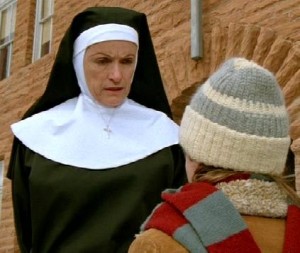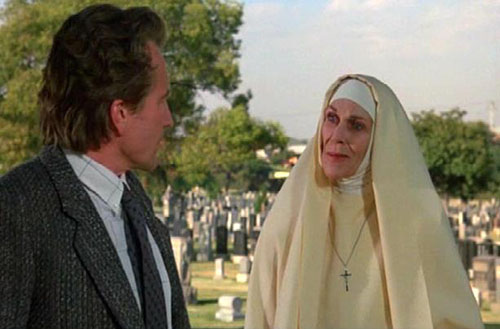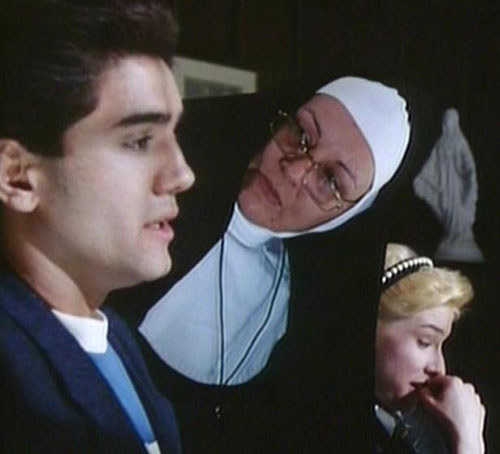Stock Background Characters 101: Holy Vessels
In this feature, we examine the lesser beings of the slasher movie realm, which, if you’re making your own slasher film, could provide a good cast roster for you.
No killer or final girl profiles here, this is a celebration of those underlings who made the most of their fleeting flirtation with stardom. And usually died.
Now, cross yourself and say your prayers, because today belongs to the HOLY VESSELS!
Overview: The humble slasher movie may not have loads to say on the subject of religion, it leaves that to the likes of The Omen and The Exorcist, but wherever there’s fundamentalist belief, there’s almost certainly horror and thus the leaders of religion. In slasher territory, it’s usually priests and nuns, and they can be nice or they can be agents of eeeeeevil.
Linguistic Snapshot: “My child, God has chosen to punish you. For the killer and his phallic weapon are what he hath sent to cleanse you of your sinful ways. Now here, drink this holy water before you BURN IN HELL!”
Styling: There’s really not much fashion variation in the church; Gok Wan would have a tantrum. Nuns don the usual habit, while priests have cloaks and collars but can at least do something with their hair: Murderous Father Jonas of Prom Night IV has a ponytail grown from years of being locked up in the depths of the church. Evil-child preacher Isaac from Children of the Corn rocks one of those old-tyme circular hats that sits like a black halo. A black halo of evil.
Hallmarks: Depending on whether the religious vessel is evil or not, hallmarks are unusually variable. For instance, Silent Night, Deadly Night‘s Mother Superior is not a villain per se, though it is she who undoubtedly plays a massive part in driving the killer’s rage come Christmas time, thanks to her strict ways and over zealous handing out of punishments for ‘naughty’ kids. There are the helpful Sisters of Christ from beyond the grave, guilt-ridden Catholic priests with secrets the Church cannot fix, cannibal satanic priests, water-bound ghost-nuns, and wannabe-hip homo-repressed fathers.
Downfall: Again, the fate of a holy vessel depends on their relationship to the victims. If they are killing them then the usual rules apply, if they are trying to save them then often they will die trying, see Father Reilly in The Boogey Man, who gets a torso full of kitchen knives as he faces down the mirror-demon thingy, and in non-slasher terms, Father Malone in The Fog, who sacrifices himself out of guilt.
Other holy vessels who serve to annoy or get in the way of the rest of the cast are summarily done in as any other victim: Ricky finally achieves what his brother never could by axing Mother Superior in Silent Night, Deadly Night Part 2 (though why she is now scarred and the absence of her strong accent remains a mystery), and a dead prom queen-possessed teen shoves a crucifix down the throat of the guilt-ridden priest in Hello Mary Lou: Prom Night II.
Father Cummings in Bloody Bloody Bible Camp gets a visit from Jesus – or Ron Jeremy – that saves him from the grave in order to save the remaining members of his flock from the psychotic killer ‘nun’.
Genesis: Religious folk have been appearing in slasher films for a long time in roles of differing significance. Alfred Sole’s anti-Catholicism flick Alice, Sweet Alice in 1976 had a zealot in a creepy plastic doll mask going on a minor killing spree, culminating in a church showdown; Wes Craven’s Deadly Blessing featured a sub-Amish community of hyper-religious folks and a mystery-killer operating in the locale, and a Loomis-aping priest tracked a psycho loon in Absurd.
Legacy: Unlike many of our other Stock Backgrounders, there’s been little change in the representation of holy folk in the genre. There are as many well-meaning ones as there are psychos: Maureen in Psycho III was a fallen nun who accidentally caused the death of another sister and was banished from the convent, only to end up at the Bates Motel where a worse fate awaited her; the ghost of Amanda Krueger whispered advice in Craig Wasson’s ear about defeating her evil undead son once and for all in A Nightmare on Elm Street 3, and returned as a younger version of herself in the fifth film.
A particularly creepy killer priest stalked college kids and some of his old comrades in Happy Hell Night, outdone twenty years later by the axe-swinging nun who terrorised the Happy Days Bloody Bloody Bible Camp (although it was set in 1984, so theoretically before Malius’ little spree), and the ghost of a nun took revenge on some old Catholic schoolgirls in…uh, The Nun. Or did she? Check out the accompanying Twist of Fury for this film’s risible revelation.
Plenty of other killers have used religion as a motive, the loon in The Majorettes, for example, who believes he is ‘purifying’ the ‘slutty’ girls of a high school cheerleadering squad.
And who could write about nuns in horror without taking a moment to recognise Jessica Lange’s Sister Jude from ‘American Horror Story’ – possibly the best nun in screen history?
Conclusions: Religion can be good or bad. I’m not a fan of it, but it certainly jazzes up some horror films when needs be. What I’d really like to see is a film with a transsexual nun. No idea why, just think it’d be awesome.







You forgot to mention those Old-timey hermits living in the woods from that movie American Gothic! Them are funny ones
True! Though I haven’t seen it in absolute years.